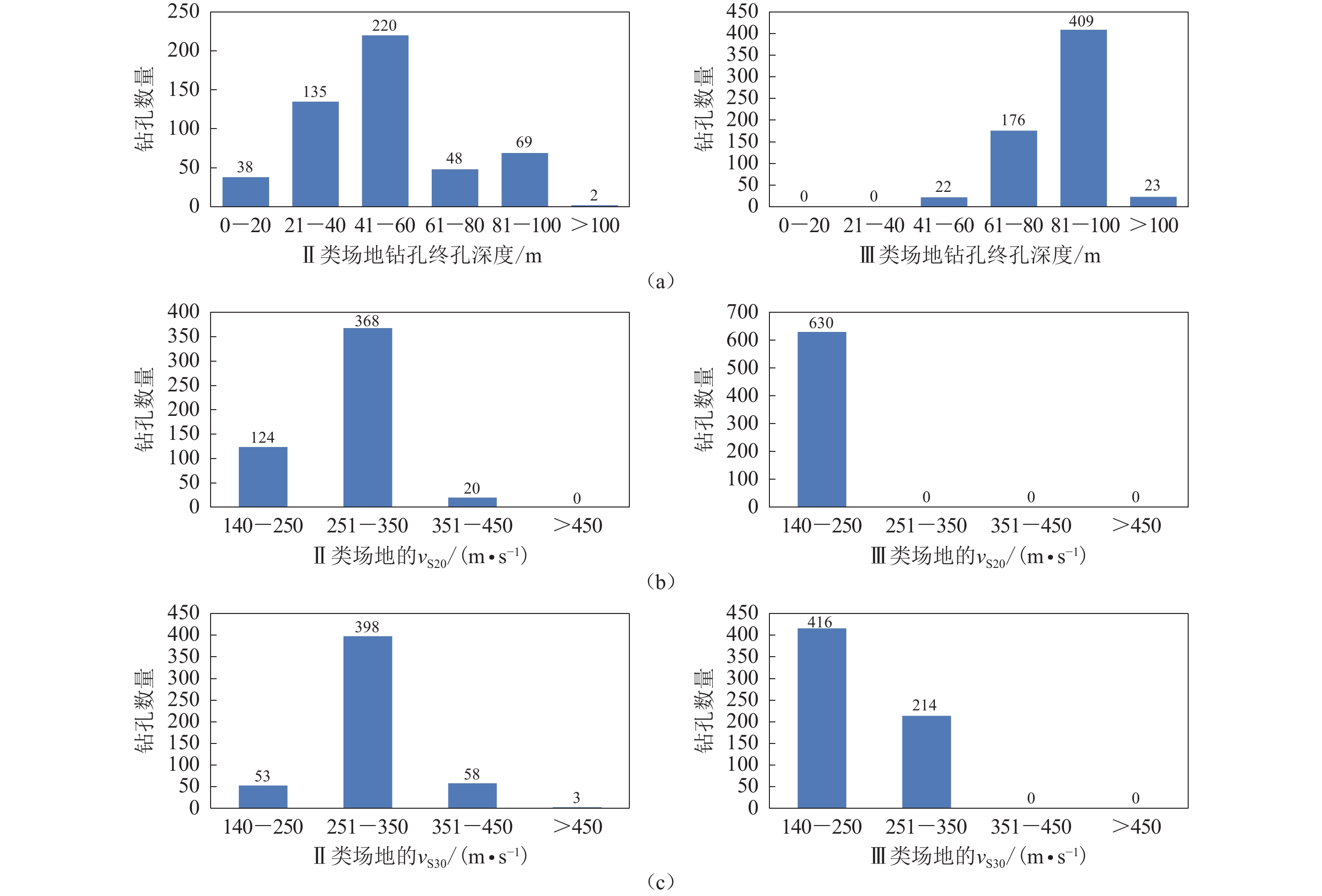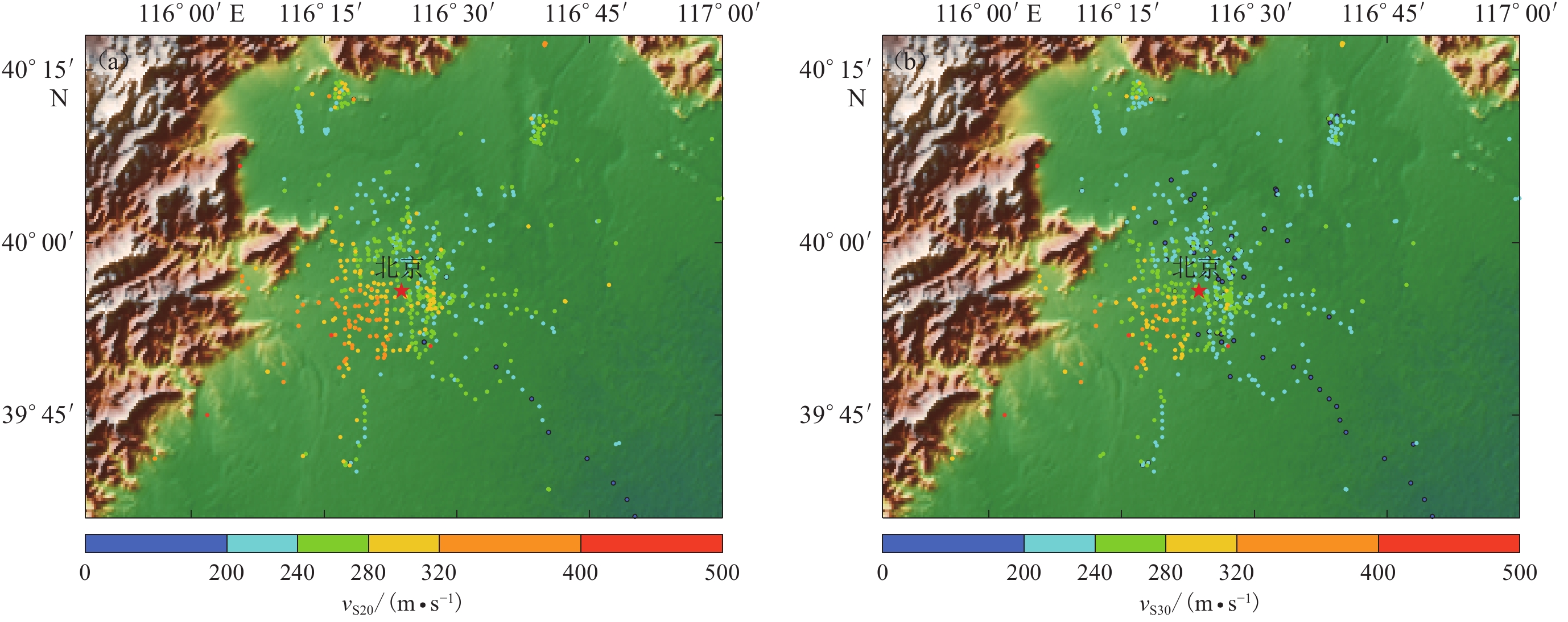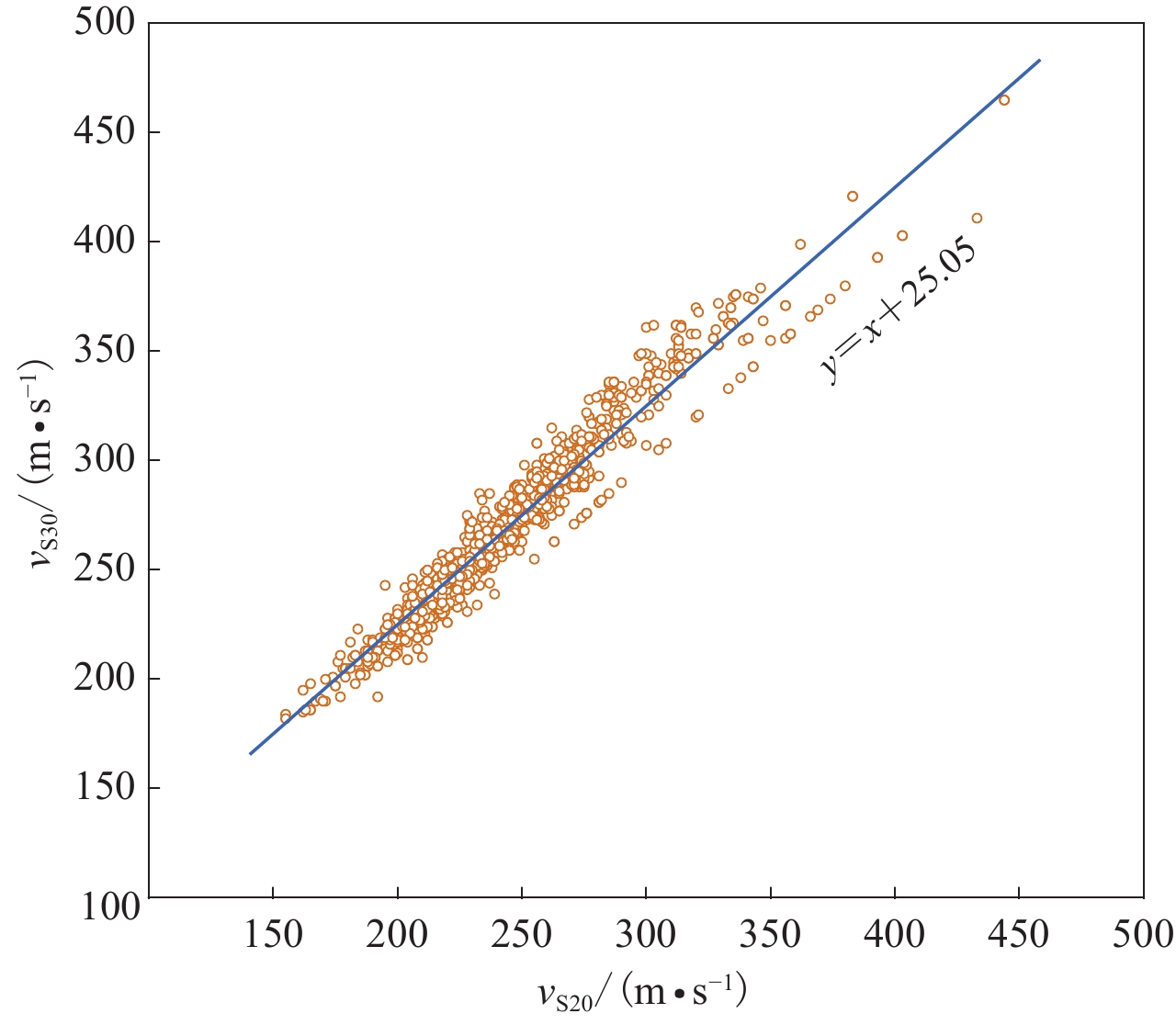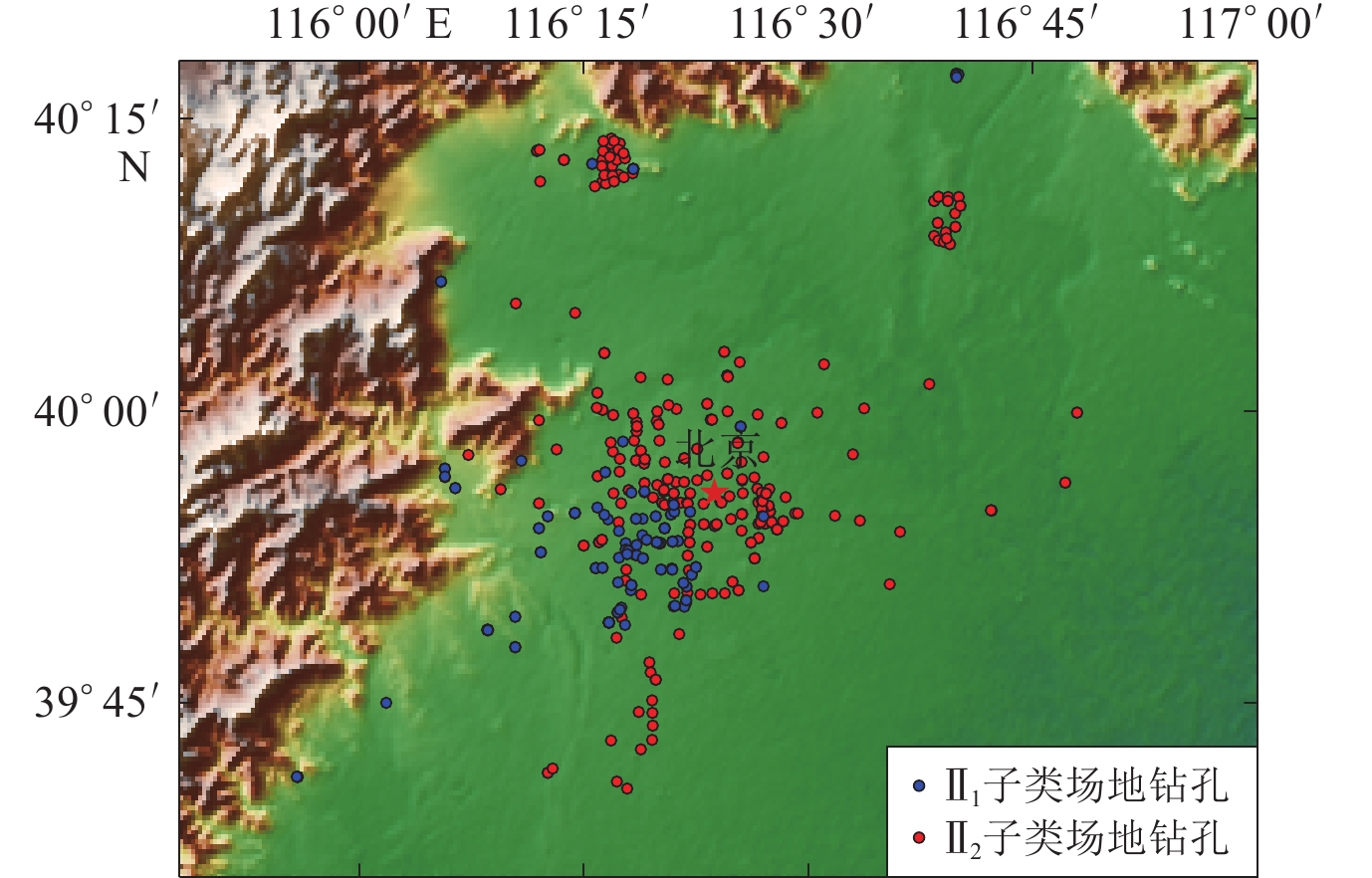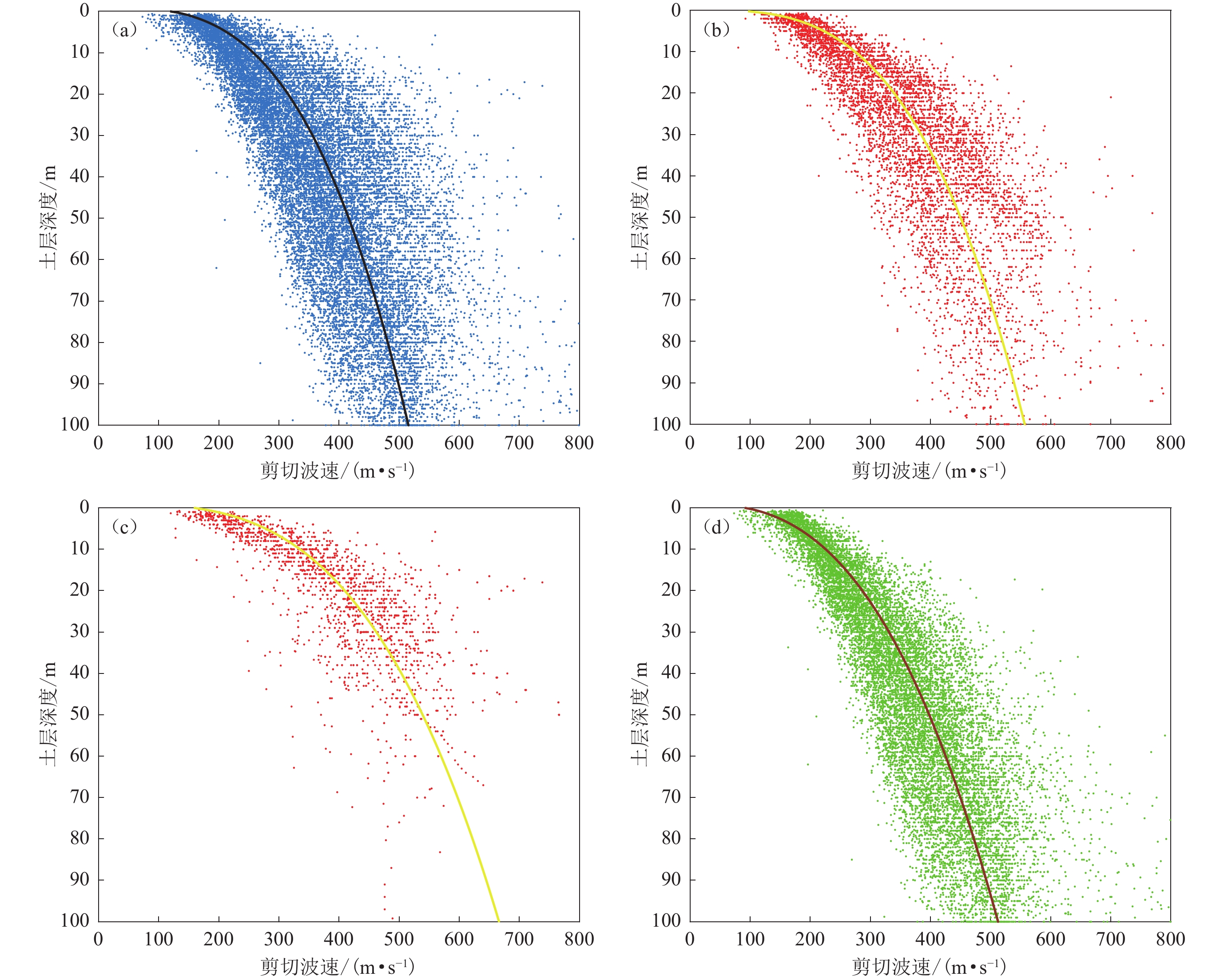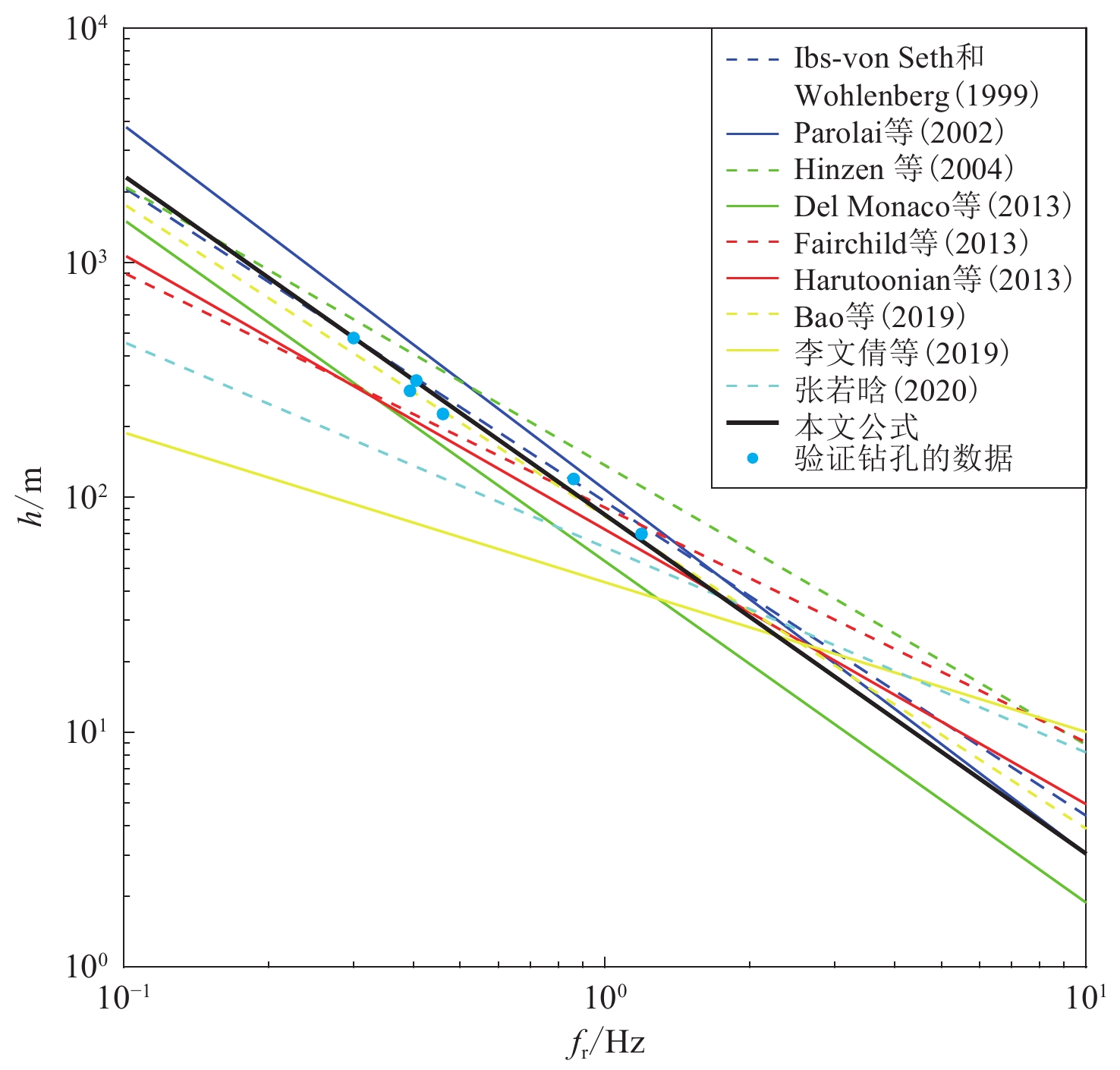Empirical relationship between overburden thickness and natural frequency based on borehole data in Beijing region
-
摘要:
针对当前北京地区缺乏适用的覆盖层厚度与场地自振频率经验关系的现状,首先利用广泛收集的北京市地震安全性评价工作中获取的1 142个钻孔数据资料,采用幂函数模型对其进行回归拟合分析,获得了土体剪切波速随深度变化的关系式,然后对该关系式进行推导建立了适合北京地区场地特征的覆盖层厚度与场地自振频率之间的经验关系,藉此为北京市无剪切波速数据的工程场地提供vS20和vS30参考,并对土层剪切波速和覆盖层厚度进行预估。
Abstract:The thickness of the site overburden layer has a significant impact on the distribution of earthquake damage. Moreover, studies have shown that when calculating the surface ground motion parameters, the uncertainty of the overburden layer thickness will lead to obvious differences for the calculation results. Therefore, giving the thickness of the site overburden layer in a scientific, reasonable and accurate manner can improve the accuracy of calculating the ground motion parameters and better estimate the earthquake damage. Traditionally, the overburden layer thickness is obtained by borehole drilling. However, borehole drilling is expensive, time-consuming and unfriendly to the ecological environment. In order to obtain the thickness of the site overburden layer economically and efficiently, many researchers have conducted in-depth studies on the typical site indicators (site natural frequency, overburden layer thickness) and established the empirical relationship between the overburden layer thickness and the site natural frequency in various research areas. However, so far, no researchers have given the empirical relationship between the site natural frequency and the overburden layer thickness in Beijing. In view of this situation, this paper conducts research on the borehole data obtained in the seismic safety evaluation work in Beijing and obtains the following results:
1) According to the current Code for Seismic Design of Buildings in China, 1142 borehole data were classified, and 512 borehole data of class Ⅱ sites and 630 borehole data of class Ⅲ sites were obtained. Then, calculations and analyses were carried out on these borehole data, and the distribution characteristics of vS20 and vS30 of class Ⅱ sites and class Ⅲ sites in the main distribution areas of the boreholes were obtained, that is, the values of vS20 and vS30 in the west and southwest are higher than those in the east and northeast. As the geographical location moves from the southwest to the northeast, vS20 and vS30 are gradually decreasing.
2) Using the model y=a (1+x)b, the borehole data were fitted under the conditions of distinguishing the site categories or not, and the empirical relationship of the soil shear wave velocity changing with depth under different conditions were obtained. Without distinguishing the site categories: vS=124.6 (0.6408+Z)0.3074; class Ⅱ 1 site category: vS=134.4 (0.1176+Z)0.3085; class Ⅱ 2 site category: vS=183.1 (−0.3965+Z)0.2739; class Ⅲ site category: vS=124.6 (0.6408+Z)0.4115.
3) The empirical relationship of the soil shear wave velocity changing with depth obtained above were derived, and the empirical relationship between the overburden layer thickness and the site natural frequency were obtained. Without distinguishing the site categories: h=84.33 fr−1.4438; class Ⅱ 1 site category: h=94.54 fr−1.4461; class Ⅱ 2 site category: h=124.63 fr−1.3772; class Ⅲ site category: h=61.55 fr−1.6992. And the obtained empirical relationships were verified. The verification results show that the empirical relationship between the overburden layer thickness and the site natural frequency established in this paper can estimate the overburden layer thickness relatively accurately.
-
Keywords:
- Beijing /
- shear-wave velocity /
- overburden layer thickness /
- fit analysis /
- natural frequency
-
引言
土层剪切波速、场地自振频率、覆盖层厚度是岩土工程勘察和工程地震中重要的场地参数,三者之间也存在很密切的联系(Ibs-von Seht,Wohlenberg,1999;Parolai et al,2002)。土层剪切波速不仅反映场地土层的软硬程度,而且在工程建筑场地类别划分、砂土液化判断等方面起着重要的作用(汪闻韶,1994);场地自振频率是场地土的重要动力特性之一,地震波在传播过程中,场地会与与其自振频率相近或相等频率的简谐波(一条复杂的地震波由数条简谐波组成)产生共振效应(因此共振频率与自振频率具有很好的一致性),因而使得地表峰值加速度大于基岩处峰值加速度;覆盖层厚度即土体地震动输入界面至地表的距离,地震动输入界面的不确定性对地表地震动参数影响较大,最大差异可达30%—40% (叶迎晨,2023)。
针对场地共振频率与覆盖层厚度的关系,研究人员已经建立了二者在不同研究区的经验公式。Ibs-von Seht和Wohlenberg (1999)利用微震动测量确定了德国莱茵河下游的沉积物厚度,推导出共振频率与覆盖层厚度之间的公式;Parolai等(2002)在德国科隆(Köln)的32个地点进行噪声测量,其重点是获得用于地震灾害评估的土体分类,同时建立了剪切波速与土层厚度、共振频率与基岩深度之间的关系式;Hinzen等(2004)在莱茵河下游测量了152个地点的环境振动,其产生的共振频率处于0.2—2.5 Hz之间,依此确定出1 200 m至10 m深度之间场地共振频率与覆盖层厚度的经验关系;Del Monaco等(2013)通过在意大利拉奎拉(Aquila)进行的地震噪声测量获取频率,建立了表层风化角砾岩厚度与频率之间的关系;Fairchild等(2013)研究了美国马萨诸塞州(Massachusetts)的基岩地形,在164个地点进行水平与竖向谱比观测,并利用基岩钻孔和地震折射测量来验证基岩深度;Harutoonian等(2013)在悉尼西部的一个动态压实填土区进行研究,微震测量产生的共振频率范围为4.2—27 Hz,对应的基岩深度为1.2—13.3 m;Bao等(2019)采用水平与竖向谱比观测获取了1976年唐山地震带附近的场地共振频率,并结合钻孔数据得到共振频率与沉积物厚度的关系,基于此估算了唐山断裂带周围的沉积物厚度;李文倩等(2019)在喀什乌恰地区筛选出21个强震动数字化观测台站作为研究对象,利用水平与竖向谱比法计算各场点的场地共振频率,并通过拟合回归分析获得了场地共振频率与覆盖层厚度的关系式;张若晗等(2020)在济南中心城区开展三分量微动测量,得到400多个测点的微动数据,计算对应的水平与竖向谱比曲线,分析不同类型曲线与地质结构的关系,并根据基岩性质总结出基岩为灰岩时地表至基岩的深度与频率的关系式。上述研究表明,各研究区域的共振频率与覆盖层厚度之间的关系式存在很大的差异,没有一个关系式能概括各个区域共振频率与覆盖层厚度关系的特点,且北京地区场地共振频率与覆盖层厚度之间的关系式尚未给出,只有陈棋福等(2008)利用Ibs-von Seht和Wohlenberg (1999)中的公式计算了北京地区的沉积物覆盖厚度,因此,利用本研究区的数据建立适合本地区的关系式非常有意义,有助于经济高效地了解北京地区的沉积物特征。
鉴于此,本研究拟利用北京地区的
1142 个钻孔数据资料,经过数据处理与分析,获得北京地区vS20和vS30的空间分布特点,并对钻孔数据进行拟合,获得土层剪切波速随深度变化的经验关系,而后对土层剪切波速随深度变化的经验关系进行推导,得出适合北京地区的覆盖层厚度与场地自振频率之间的关系式,并对其进行检验与分析,以期为土层地震反应分析中的土层模型提供岩土分界面参考,从而对场地放大效应进行更为精细的估计。1. 北京市地质地貌及第四纪沉积物
北京市地处华北平原,其西部、北部与群山相连,东南部地貌平坦广阔,由洪积扇、冲洪积扇群和冲积平原联合而成。区内地貌特征主要由河流的不断变迁、侵蚀和堆积所控制,从西到东形成了阶梯状的地貌轮廓,依次可划分为山麓-山前地貌带和冲积平原地貌区,其中:山麓-山前地貌带包括丘陵、残丘、台地和洪积扇,为山区向平原的过渡带;冲积平原地貌区地势较为平坦,向南倾斜,平均海拔为50—60 m。在冲积平原上,发育河流地貌,包括现代河流和古河道,古河道在区内主要由永定河多次改道形成(施春花,2009)。
第四纪以来,北京平原地区差异运动强烈,在不同方向断裂的影响下,第四纪沉积层厚度的差异较大,例如沙河、平谷、天竺、怀柔南等地分布着大小不等的第四纪沉积盆地,盆地中心的沉积层厚度一般为300—400 m,最深可达600 m 以上,而城区第四纪沉积层厚度为 60—80 m 左右,市区西郊八宝山—公主坟一带只有十多米,甚至基岩裸露。从总体上看,第四纪沉积物形成了比较明显的向东南倾斜的特征,且厚度逐渐加大,在沉积盆地内形成了几个明显的沉积中心,如孙河—天竺、马池口—沙河、昆明湖—四季青、牛堡屯—王各庄、怀柔、平谷等沉积中心(江志杰等,2018)。
从松散沉积物的空间分布和地质剖面上的变化来看,北京地区从山区到平原,从西北到东南均呈现显著的沉积物分带特点。西部地区主要是由洪积形成的粗碎屑沉积物,主要为卵石、砾石等沉积物,它们组成了洪积扇的顶部;向东,沉积物由粗逐渐变细,由砂与黏性土互层结构逐渐变为以黏性土层为主体。这样的分带特点是洪积、冲积物质重力分选的结果。图1所示为北京地区的第四纪沉积物等厚线图。
2. 数据初步处理与分析
本研究收集了近年来北京市用于地震安全性评价工作中的1 144个钻孔资料,并依据我国现行的建筑抗震设计规范GB 50011—2010 (中国建筑科学研究院,2010)对钻孔所处位置的场地进行分类,其中Ⅰ类场地上无钻孔,Ⅱ类和Ⅲ类场地上分别有512个和630个钻孔,Ⅳ类场地上仅有2个钻孔。由于Ⅰ类场地上无钻孔以及Ⅳ类场地上钻孔极少,未能对这两类场地进行分析,因此利用1 142个钻孔资料对Ⅱ类和Ⅲ类场地上的土体进行分析,所给出的经验关系也只能适用于Ⅱ类和Ⅲ类场地上剪切波速和覆盖层厚度的预估。本文所用到的1 142个钻孔大多数位于北京市六环以内,如图2所示。
图3给出了不同类别场地上不同终孔深度的钻孔数量以及vS20分布和vS30分布的钻孔数量。可见:Ⅱ类和Ⅲ类场地上的钻孔终孔深度主要分别分布于20—60 m和60—100 m范围内(图3a);Ⅱ类和Ⅲ类场地上的vS20主要取值范围分别为140—350 m/s和140—250 m/s,Ⅱ类场地上的vS20相较于Ⅲ类场地上的vS20跨度更广、更离散,Ⅲ类场地的vS20较为集中(图3b);Ⅱ类和Ⅲ类场地上的vS30主要取值范围分别为250—350 m/s和140—350 m/s (图3c)。图4为北京地区vS20和vS30的空间分布。
由图2可知,Ⅱ类场地主要位于北京六环内的西部及西南部,Ⅲ类场地主要位于东部及东北部。这使得北京六环及附近区域的vS20和vS30空间分布特征呈西部及西南部数值高于东部及东北部。如图4所示,从北京西南部到东北部,vS20和vS30逐渐减小。此外,对所有钻孔的vS20和vS30数据进行拟合,得到二者之间的关系式,具体拟合情况如图5所示,所得关系式的拟合优度为
0.9422 ,这说明二者存在显著的线性相关性。本研究基于所用数据绘制出的北京地区vS20和vS30空间分布图(图4)在特征上与施春花(2009)和陈国兴等(2020)所绘制的vS20和vS30空间分布图相似,即西部及西南部的vS20和vS30值高于东部及东北部。本研究在绘制vS20和vS30空间分布图时,使用了1 142个钻孔数据,施春花(2009)使用了475个钻孔数据,陈国兴等(2020)使用了412个钻孔数据,因此图4相较于施春花(2009)和陈国兴等(2020)的分布图覆盖了更广的范围、具有更充足的数据,可为北京地区无钻孔数据的地方提供更为可靠的vS20和vS30参考值。
3. 数据拟合分析
土体剪切波速与土体埋深关系的研究表明土体剪切波速与土体埋深具有一定的统计关系,已有研究基于各种模型的拟合统计给出了剪切波速随深度变化的经验公式(Ibs-von Seht,Wohlenberg,1999;Parolai et al,2002;战吉艳等,2009;刘红帅等,2010;李建有等,2012;齐鑫,丁浩,2012;王金艳,侯莹,2017;沈方铝等,2018;蔡润等,2022),以及vS20和vS30外推模型的建立与验证(Xie et al,2016;贾琳等,2021)。根据Ibs-von Seht和Wohlenberg (1999),速度随深度变化的关系式为:
$$ {v}_{{\mathrm{S}}} ( {\textit{z}} ) ={v}_{{\mathrm{S}}0} ( 1 + Z{ ) }^{x} , $$ (1) 式中,z为土层深度,Z=z/z0 (z0=1 m),vS0为表面剪切波速,x为深度对速度的影响因子。Parolai等(2002)的研究表明,不同研究区域都有最适合本区域的vS0和x参数,因此为了得到最适合北京地区的vS0和x,本研究以1 142个钻孔数据为基础,采用y=a (1+x)b的拟合模型对数据进行拟合。
对数据进行拟合的过程中发现, Ⅱ类场地上的钻孔数据离散性很大,且拟合优度较低,因此以钻孔vS20和vS30为特征指标,采用K均值聚类方法进行分类,将Ⅱ类场地上的钻孔分成Ⅱ 1和Ⅱ 2两个子类,且这两个子类的钻孔在地理位置上有一定的聚集特征,具体钻孔位置如图6所示。
同理,对Ⅲ类场地的钻孔数据也进行分析,结果显示:划分子类后,数据的拟合优度提升得并不明显;各子类钻孔位置分布不像Ⅱ类场地钻孔那样存在一定的聚集性。因此将Ⅲ类钻孔数据作为一个整体予以分析。
图7所示为未分类与分类时钻孔数据的拟合结果。可以明显地看出:随着土层深度逐渐增加,剪切波速也在变大,随之还伴随着速度离散性的增强;在Ⅱ类场地上,土层剪切波速随深度变化的变化率大于Ⅲ类场地上的变化率,且随着深度的增加,Ⅱ类场地上土层剪切波速的离散性大于Ⅲ类场地上的离散性。由于钻孔是用于地震安全性评价工作,绝大部分钻孔的终孔深度是在100 m范围以内,但拟合结果对更深层土的剪切波速具有一定的预测作用。100 m深度范围内剪切波速与土体深度的拟合结果列于表1。从拟合标准差来看,Ⅲ类场地上钻孔的拟合标准差最小;从拟合优度来看,各拟合关系式的拟合优度都较高,因此,各经验公式对100 m范围内土层剪切波速有着不错的估计效果。
表 1 0—100 m深度范围内剪切波速vS与土体深度Z的拟合结果Table 1. Fitting results of shear wave velocity vS and soil depth Z within the depth range of 0—100 m拟合情况 拟合所得关系式 拟合标准差 拟合优度 未区分场地类别 vS=124.6 ( 0.6408 +Z)0.3074 67.54 0.642 1 Ⅱ类场地Ⅱ 1子类 vS=134.4 ( 0.1176 +Z)0.3085 63.94 0.689 4 Ⅱ类场地Ⅱ 2子类 vS=183.1 (− 0.3965 +Z)0.2739 66.18 0.689 6 Ⅲ类场地 vS=124.6 ( 0.6408 +Z)0.4115 54.21 0.760 9 从表1中Ⅱ类场地(Ⅱ 1 子类和Ⅱ 2 子类)、Ⅲ类场地的关系式比较而言,Ⅱ类场地类别计算公式的拟合标准差偏大,拟合优度偏小,这说明Ⅱ类场地上土层的剪切波速离散性较大。从北京地区钻孔位置分布(图2)来看,Ⅱ类场地分布更为广泛,从山区到平原均有分布,主要分布在北京六环内的西部及西南部,靠近西部山区地带,这些地带的沉积物以卵石、砾石为主,向东沉积物由粗逐步变细(施春花,2009),而卵石往往比同一深度的砂土、黏性土具有更大的波速,且不同深度之间的波速差异更大,这是Ⅱ类场地土层剪切波速离散性大的原因。
4. 土层覆盖层厚度与场地自振频率关系的建立以及关系式的检验
本研究基于对北京地区大量钻孔数据的分析,获得一个符合北京地区剪切波速随深度变化的经验关系,在此基础上经过推导,得到土层覆盖厚度h与场地共振频率fr之间的关系,具体推导过程如下:
根据定义 $ v ( {\textit{z}} ) ={\mathrm{d}}{\textit{z}}/{\mathrm{d}}t $,再结合式(1),则剪切波从基岩处到达地表的时间t0为
$$ {t}_{0}={\int_0^h} \frac{{\mathrm{d}}{\textit{z}}}{{v}_{{\mathrm{S}}} ( {\textit{z}} ) }={\int_0^h} \frac{{\mathrm{d}}{\textit{z}}}{{v}_{{\mathrm{S}}0} ( 1 + Z{ ) }^{x}}=\frac{1}{{v}_{{\mathrm{S}}0}}{\int_0^h} { ( 1 + Z ) }^{-x}{\mathrm{d}}{\textit{z}}=\frac{1}{{v}_{{\mathrm{S}}0}}\frac{{ ( 1 + h ) }^{1-x}-1}{1-x} \text{,} $$ (3) 而t0与场地共振频率fr又存在如下关系:
$$ {t}_{0}=\frac{1}{4{f}_{{\mathrm{r}}}}\text{,} $$ (4) 则有
$$ {t}_{0}=\frac{1}{4{f}_{{\mathrm{r}}}}=\frac{1}{{v}_{{\mathrm{S}}0}}\frac{{ ( 1 + h ) }^{1-x}-1}{1-x}\text{,} $$ (5) 因此场地共振频率fr与覆盖层厚度h之间的关系式可写为
$$ h={\left[\frac{{v}_{\mathrm{S}0} ( 1-x ) }{4{f}_{\mathrm{r}}} + 1\right]}^{1/ ( 1-x ) }-1. $$ (6) 当$ {v}_{\mathrm{S}0} ( 1-x ) $≫$ {4f}_{{\mathrm{r}}} $时,上式可写为
$$ h={\left[\frac{{v}_{\mathrm{S}0} ( 1-x ) }{4}\right]}^{1/ ( 1-x ) }{f}_{\mathrm{r}}^{-1/ ( 1-x ) }=a{f}_{\mathrm{r}}^{b} \text{,} $$ (7) 式中
$$ a={\left[\frac{{v}_{\mathrm{S}0} ( 1-x ) }{4}\right]}^{1/ ( 1-x ) } \text{,} b=-\frac{1}{1-x}. $$ 将前文中各情况拟合得到的地表剪切波速vS0与深度对速度的影响因子x带入上述a和b的计算公式中,可得到适合北京地区的h与fr之间的关系式。表2列出了各研究区域h与fr之间的关系式。
表 2 不同研究区域土层覆盖厚度h与场地共振频率fr的关系式Table 2. Relationship between overburden thickness h and resonance frequency fr in different regions研究区域 来源 关系式 用于研究的钻孔数量 德国莱茵河 Ibs-von Seth和Wohlenberg (1 999) $ h=96{f}_{\mathrm{r}}^{-1.388} $ 102 德国科隆 Parolai等(2 002) $ h=108{f}_{\mathrm{r}}^{-1.551} $ 337 德国科隆 Hinzen 等(2 004) $ h=137{f}_{\mathrm{r}}^{-1.190} $ 152 意大利拉奎拉 Del Monaco等(2 013) $ h=53.461{f}_{\mathrm{r}}^{-1.4541} $ 25 美国马萨诸塞州 Fairchild等(2 013) $ h=90.53{f}_{\mathrm{r}}^{-1.0} $ 164 澳大利亚悉尼 Harutoonian等(2 013) $ h=73{f}_{\mathrm{r}}^{-1.170} $ 15 中国唐山 Bao等(2 019) $ h=83{f}_{\mathrm{r}}^{-1.33} $ 21 中国新疆 李文倩等(2 019) $ h=43.53{f}_{\mathrm{r}}^{-0.638} $ 18 中国济南 张若晗等(2 020) $ h=61.34{f}_{\mathrm{r}}^{-0.874} $ 25 中国北京 本研究(不区分场地) $ h=84.33{f}_{\mathrm{r}}^{-1.4438} $ 1142 本研究[Ⅱ类场地(Ⅱ 1子类)] $ h=94.54 $$ {f}_{\mathrm{r}}^{-1.4461} $ 512 本研究[Ⅱ类场地(Ⅱ 2子类)] $ h=124.63{f}_{\mathrm{r}}^{-1.3772} $ 本研究(Ⅲ类场地) $ h=61.55{f}_{\mathrm{r}}^{-1.6992} $ 630 鉴于场地自振频率与场地共振频率具有很好的一致性,本研究采用场地共振频率作为场地自振频率。为了验证h与fr关系的可行性,我们查寻研究区域附近的深孔资料:钻孔SHBZK1,SHBZK2和SHBZK3 (彭菲等,2020)用于研究断层活动;钻孔ZK07,ZK08和ZK14用于断裂位置识别以及地层划分研究。这六个验证钻孔区别于本文中所使用的用于地震安全性评价的钻孔,其钻探深度穿越了基岩面,因此非常适于验证h与fr关系的可行性。在各研究人员所给出的h与fr的关系式中,Ibs-von Seht和Wohlenberg (1999)的关系式是应用最广泛的,陈棋福等(2008)也采用该关系式计算了北京地区的覆盖层厚度,其结果与其他研究人员给出的覆盖层厚度表现出良好的一致性,因此,我们就验证钻孔处覆盖层的计算厚度,对本研究关系式与Ibs-von Seht和Wohlenberg (1999)的关系式进行比较,结果列于表3。
表 3 本文关系式与Ibs-von Seht和Wohlenberg (1999)公式关于验证钻孔处覆盖层厚度的计算对比Table 3. Comparison of overburden thickness estimation at the verification boreholes by the fitting expression in this study with that from Ibs-von Seht and Wohlenberg (1999)钻孔编号 实际基岩深度/m 共振频率/Hz 本研究公式 Ibs-von Seht和Wohlenberg (1 999)公式 覆盖层计算深度/m 偏差率 覆盖层计算深度/m 偏差率 ZK07 315.0 0.405 310.98 1.27% 336.61 6.86% ZK08 478.0 0.300 479.64 0.34% 510.54 6.81% ZK14 284.8 0.393 324.79 14.36% 350.96 23.23% SHBZK1 227.0 0.460 258.76 13.98% 282.07 24.26% SHBZK2 70.0 1.190 75.41 6.28% 75.41 7.72% SHBZK3 120.0 0.860 104.85 12.63% 118.36 13.71% 由于未获取上述六个验证钻孔的详细资料,无法对验证钻孔处的场地进行场地类别判断,因此选择采用未分类情况下得到的h-fr关系式计算钻孔处的覆盖层厚度。钻孔SHBZK1,SHBZK2和SHBZK3处的场地共振频率由实地测量得到;钻孔ZK07,ZK08和ZK14的共振频率并不是通过实地测量得到,而是根据相关文献中利用插值所得的覆盖层厚度和h-fr关系式反推所得。从表3的计算结果来看,钻孔ZK07,ZK08,SHBZK2和SHBZK3的实际基岩深度与计算得到的覆盖层厚度非常接近,特别是对于钻孔ZK07,ZK08和SHBZK2来说,计算偏差相较于基岩深度几乎可以忽略不计;钻孔ZK14和SHBZK1的实际基岩深度与计算得到的覆盖层厚度之间的偏差略大于钻孔ZK07,ZK08,SHBZK2和SHBZK3的偏差,但也属于较吻合的情况;本研究建立的公式在计算偏差率上整体优于Ibs-von Seht和Wohlenberg (1999)公式;从最大计算偏差率来看,本研究关系式的最大计算偏差率为14.36%,优于Ibs-von Seht 和Wohlenberg (1999)公式的24.26%,这说明本研究基于钻孔数据推导的方法是可行的,所给出的关系式符合北京地区h-fr关系特点,能够填补北京地区h-fr关系式的欠缺。以上六个用来进行验证的钻孔,其估计误差均小于40 m,其中三个的估计误差小于10 m,从这一验证结果来看,本文所给出的h-fr关系式具有良好的置信水平,能够对场地覆盖层厚度进行较为准确的估计,较好地揭示了岩土分界面。
图8为各研究人员所给出的h-fr关系式与本研究所给出关系式(未分类情况下的关系式)的对比图,可以看出,就北京附近区域的覆盖层厚度而言,本研究所给出的关系式相较于其他研究人员给出的关系式有着更好的估计效果。
5. 讨论与结论
本研究对北京地区的覆盖层厚度与场地自振频率的经验关系进行了研究,主要结论如下:
1) 在对北京市大量的地震安全性评价钻孔的剪切波速实测数据分析的基础上,绘制出较前人分辨率更高的北京地区vS20和vS30空间分布图,该图可为北京地区无剪切波速实测数据的地方提供vS20和vS30数值参考。
2) 基于对北京地区土体剪切波速随土层深度变化关系的研究,给出了是否区分场地类别情况下土体剪切波速随土层深度变化的统计公式,所给出的统计公式可用于北京地区地下100 m深度范围内的土体剪切波速预测。
3) 基于数据拟合与公式推导,给出了适用于北京地区的场地自振频率与覆盖层厚度之间的关系,填补了北京地区无h-fr关系式的空白。从本文验证结果来看,所给出的不区分场地类别情况下的h-fr关系式对覆盖层厚度有着良好的估计,能高效地、经济地为北京地区无钻孔资料地方预测覆盖层厚度、北京地区进行沉积起伏特征调查以及土层地震反应分析中确定地震动输入界面以及抗震设防提供参考。
4) 在土层剪切波速随深度变化关系的拟合中可以看到,剪切波速的离散性并不小,这与沉积物特点有关。北京地区向西为太行山脉,向北为阴山山脉和大兴安岭山脉,向东为渤海海域,向南为华北平原,处于从山地向平原过渡的位置,自西向东、从南向北山地逐渐过渡为平原。地形变化的同时,也伴随着沉积物的变化,从山区到平原,从西北到东南均有显著的沉积物分带性。西部地区主要以卵石、砾石等沉积物为主;向东,沉积物由粗逐步变细,由砂和黏性土互层结构逐渐变为以黏性土层为主体的沉积层。土层结构存在明显差异,各区域沉积物的不均匀性可能是造成剪切波速离散性大的原因。
本研究的初衷是希望通过对剪切波速与深度的拟合以及公式推导,得到一个符合北京地区且具备综合评估能力的覆盖层厚度与自振频率的关系式,因此未将数据进行细分。而在施春花(2009)的研究中,其基于地形地貌、新构造运动特征、沉积物沉积环境、第四纪沉积层厚度及活动构造分布等资料对北京地区的工程地质条件进行了划分。若以钻孔地处的工程地质分区对钻孔分组进行相关研究,得到的结果可能会更详细,离散性会更小。下一步将在此方向上进行更深入的研究。
-
表 1 0—100 m深度范围内剪切波速vS与土体深度Z的拟合结果
Table 1 Fitting results of shear wave velocity vS and soil depth Z within the depth range of 0—100 m
拟合情况 拟合所得关系式 拟合标准差 拟合优度 未区分场地类别 vS=124.6 ( 0.6408 +Z)0.3074 67.54 0.642 1 Ⅱ类场地Ⅱ 1子类 vS=134.4 ( 0.1176 +Z)0.3085 63.94 0.689 4 Ⅱ类场地Ⅱ 2子类 vS=183.1 (− 0.3965 +Z)0.2739 66.18 0.689 6 Ⅲ类场地 vS=124.6 ( 0.6408 +Z)0.4115 54.21 0.760 9 表 2 不同研究区域土层覆盖厚度h与场地共振频率fr的关系式
Table 2 Relationship between overburden thickness h and resonance frequency fr in different regions
研究区域 来源 关系式 用于研究的钻孔数量 德国莱茵河 Ibs-von Seth和Wohlenberg (1 999) $ h=96{f}_{\mathrm{r}}^{-1.388} $ 102 德国科隆 Parolai等(2 002) $ h=108{f}_{\mathrm{r}}^{-1.551} $ 337 德国科隆 Hinzen 等(2 004) $ h=137{f}_{\mathrm{r}}^{-1.190} $ 152 意大利拉奎拉 Del Monaco等(2 013) $ h=53.461{f}_{\mathrm{r}}^{-1.4541} $ 25 美国马萨诸塞州 Fairchild等(2 013) $ h=90.53{f}_{\mathrm{r}}^{-1.0} $ 164 澳大利亚悉尼 Harutoonian等(2 013) $ h=73{f}_{\mathrm{r}}^{-1.170} $ 15 中国唐山 Bao等(2 019) $ h=83{f}_{\mathrm{r}}^{-1.33} $ 21 中国新疆 李文倩等(2 019) $ h=43.53{f}_{\mathrm{r}}^{-0.638} $ 18 中国济南 张若晗等(2 020) $ h=61.34{f}_{\mathrm{r}}^{-0.874} $ 25 中国北京 本研究(不区分场地) $ h=84.33{f}_{\mathrm{r}}^{-1.4438} $ 1142 本研究[Ⅱ类场地(Ⅱ 1子类)] $ h=94.54 $$ {f}_{\mathrm{r}}^{-1.4461} $ 512 本研究[Ⅱ类场地(Ⅱ 2子类)] $ h=124.63{f}_{\mathrm{r}}^{-1.3772} $ 本研究(Ⅲ类场地) $ h=61.55{f}_{\mathrm{r}}^{-1.6992} $ 630 表 3 本文关系式与Ibs-von Seht和Wohlenberg (1999)公式关于验证钻孔处覆盖层厚度的计算对比
Table 3 Comparison of overburden thickness estimation at the verification boreholes by the fitting expression in this study with that from Ibs-von Seht and Wohlenberg (1999)
钻孔编号 实际基岩深度/m 共振频率/Hz 本研究公式 Ibs-von Seht和Wohlenberg (1 999)公式 覆盖层计算深度/m 偏差率 覆盖层计算深度/m 偏差率 ZK07 315.0 0.405 310.98 1.27% 336.61 6.86% ZK08 478.0 0.300 479.64 0.34% 510.54 6.81% ZK14 284.8 0.393 324.79 14.36% 350.96 23.23% SHBZK1 227.0 0.460 258.76 13.98% 282.07 24.26% SHBZK2 70.0 1.190 75.41 6.28% 75.41 7.72% SHBZK3 120.0 0.860 104.85 12.63% 118.36 13.71% -
蔡润,彭涛,罗东林,周亚东,尹欣欣,郭鹏,彭界超. 2022. 成都地区土层剪切波速与埋深的关系[J]. 地震研究,45(3):498–508. Cai R,Peng T,Luo D L,Zhou Y D,Yin X X,Guo P,Peng J C. 2022. Correlation between the shear wave velocity and the soil depth in Chengdu region[J]. Journal of Seismological Research,45(3):498–508 (in Chinese).
陈国兴,丁杰发,方怡,彭艳菊,李小军. 2020. 场地类别分类方案研究[J]. 岩土力学,41(11):3509–3522. Chen G X,Ding J F,Fang Y,Peng Y J,Li X J. 2020. Investigation of seismic site classification scheme[J]. Rock and Soil Mechanics,41(11):3509–3522 (in Chinese).
陈棋福,刘澜波,王伟君,Rohrbach E. 2008. 利用地脉动探测北京城区的地震动场地响应[J]. 科学通报,53(18):2229–2235. doi: 10.3321/j.issn:0023-074X.2008.18.013 Chen Q F,Liu L B,Wang W J,Rohrbach E. 2009. Site effects on earthquake ground motion based on microtremor measurements for metropolitan Beijing[J]. Chinese Science Bulletin,54(2):280–287. doi: 10.1007/s11434-008-0422-2
贾琳,谢俊举,李小军,温增平,陈文彬,周健. 2021. 四川和云南地区场地平均剪切波速vS20和vS30经验预测模型研究[J]. 地震学报,43(5):628–642. Jia L,Xie J J,Li X J,Wen Z P,Chen W B,Zhou J. 2021. Empirical prediction models of time-averaged shear wave velocity vS20 and vS30 in Sichuan and Yunnan areas[J]. Acta Seismologica Sinica,43(5):628–642 (in Chinese).
江志杰,彭艳菊,方怡,吕悦军,修立伟,黄帅. 2018. 北京平原地区vS30估算模型适用性研究[J]. 震灾防御技术,13(1):75–86. Jiang Z J,Peng Y J,Fang Y,Lü Y J,Xiu L W,Huang S. 2018. Applicability of vS30 estimation models for the Beijing plain area[J]. Technology for Earthquake Disaster Prevention,13(1):75–86 (in Chinese).
李建有,王朝进,徐兴倩,林凤仙. 2012. 昆明盆地剪切波速与土层深度关系的统计分析[J]. 云南大学学报(自然科学版),34(增刊):43–47. Li J Y,Wang C J,Xu X Q,Lin F X. 2012. Statistical analysis of relationship between shear wave velocity and depth of soils in Kunming basin[J]. Journal of Yunnan University,34(S2):43–47 (in Chinese).
李文倩,何金刚,朱皓清. 2019. 基于H/V谱比法的场地卓越频率研究[J]. 内陆地震,33(4):314–320. Li W Q,He J G,Zhu H Q. 2019. Study on site predominant frequency based on H/V spectral ratio method[J]. Inland Earthquake,33(4):314–320 (in Chinese).
刘红帅,郑桐,齐文浩,兰景岩. 2010. 常规土类剪切波速与埋深的关系分析[J]. 岩土工程学报,32(7):1142–1149. Liu H S,Zheng T,Qi W H,Lan J Y. 2010. Relationship between shear wave velocity and depth of conventional soils[J]. Chinese Journal of Geotechnical Engineering,32(7):1142–1149 (in Chinese).
彭菲,王伟君,寇华东. 2020. 三河—平谷地区地脉动H/V谱比法探测:场地响应、浅层沉积结构及其反映的断层活动[J]. 地球物理学报,63(10):3775–3790. Peng F,Wang W J,Kou H D. 2020. Microtremer H/V spectral ratio investigation in the Sanhe-Pinggu area:Site responses,shallow sedimentary structure,and fault activity revealed[J]. Chinese Journal of Geophysics,63(10):3775–3790 (in Chinese).
齐鑫,丁浩. 2012. 下辽河平原区剪切波速与土层埋深关系分析[J]. 世界地震工程,28(3):151–156. Qi X,Ding H. 2012. Analysis of relationship between shear wave velocity and depth of soil layers in downstream Liaohe River plain[J]. World Earthquake Engineering,28(3):151–156 (in Chinese).
沈方铝,李培,张颖,任丛荣,黄宗林. 2018. 福州市区土层剪切波速与土层深度的经验关系研究[J]. 地震工程学报,40(增刊):83–89. Shen F L,Li P,Zhang Y,Ren C R,Huang Z L. 2018. Empirical relationship between shear-wave velocity and depth of soils in Fuzhou downtown area[J]. China Earthquake Engineering Journal,40(S1):83–89 (in Chinese).
施春花. 2009. 北京地区场地条件对地震动参数的影响[D]. 北京:中国地震局地壳应力研究所:1−114. Shi C H. 2009. A Study of the Effect of Site Conditions on Seismic Ground Motion Parameters in Beijing Area[D]. Beijing:Institute of Crustal Dynamics,China Earthquake Administration:1−114 (in Chinese).
王金艳,侯莹. 2017. 常州市城区土层剪切波速与土层深度关系分析[J]. 地震工程学报,39(增刊):236–240. Wang J Y,Hou Y. 2017. Relation between shear wave velocity and soil depth in the urban area of Changzhou City[J]. China Earthquake Engineering Journal,39(S1):236–240 (in Chinese).
汪闻韶. 1994. 土工地震减灾工程中的一个重要参量:剪切波速[J]. 水利学报,(3):80–84. Wang W S. 1994. An important parameter in geotechnical engineering for earthquake disaster mitigation:Shear wave velocity[J]. Journal of Hydraulic Engineering,(3):80–84 (in Chinese).
叶迎晨. 2023. 深厚覆盖层地区土层地震反应的不确定性分析[J]. 地震科学进展,53(5):193–202. Ye Y C. 2023. Uncertainty analysis of seismic response of soil layer in deep overburden area[J]. Progress in Earthquake Sciences,53(5):193–202 (in Chinese).
战吉艳,陈国兴,刘建达. 2009. 苏州城区深软场地土剪切波速与土层深度的经验关系[J]. 世界地震工程,25(2):11–17. Zhan J Y,Chen G X,Liu J D. 2009. Empirical relationship between shear wave velocity and soil depth on deep soft sites in urban area of Suzhou city[J]. World Earthquake Engineering,25(2):11–17 (in Chinese).
张若晗,徐佩芬,凌甦群,杜亚楠,游志伟,王志辉,孙成禹. 2020. 基于微动H/V谱比法的土石分界面探测研究:以济南中心城区为例[J]. 地球物理学报,63(1):339–350. Zhang R H,Xu P F,Ling S Q,Du Y N,You Z W,Wang Z H,Sun C Y. 2020. Detection of the soil-rock interface based on microtremor H/V spectral ratio method:A case study of the Jinan urban area[J]. Chinese Journal of Geophysics,63(1):339–350 (in Chinese).
中国建筑科学研究院. 2010. GB 50011—2010建筑抗震设计规范[S]. 北京:中国建筑工业出版社:18−20. China Academy of Building Research. 2010. GB 50011—2010 Code for Seismic Design of Buildings[S]. Beijing:China Architecture & Building Press:18−20 (in Chinese).
Bao F,Li Z W,Tian B F,Wang L L,Tu G H. 2019. Sediment thickness variations of the Tangshan fault zone in North China from a dense seismic array and microtremor survey[J]. J Asian Earth Sci,185:104045. doi: 10.1016/j.jseaes.2019.104045
Del Monaco F,Tallini M,De Rose C,Durante F. 2013. HVNSR survey in historical downtown L’Aquila (central Italy):Site resonance properties vs. subsoil model[J]. Eng Geol,158:34–47.
Fairchild G M,Lane J W,Voytek E B,LeBlanc D R. 2013. Bedrock Topography of Western Cape Cod,Massachusetts,Based on Bedrock Altitudes From Geologic Borings and Analysis of Ambient Seismic Noise by the Horizontal-to-Vertical Spectral-Ratio Method:Scientific Investigations Map 3233[R]. Reston:U. S. Geological Survey:17.
Harutoonian P,Leo C J,Tokeshi K,Doanh T,Castellaro S,Zou J J,Liyanapathirana D S,Wong H. 2013. Investigation of dynamically compacted ground by HVSR-based approach[J]. Soil Dyn Earthq Eng,46:20–29. doi: 10.1016/j.soildyn.2012.12.004
Hinzen K G,Weber B,Scherbaum F. 2004. On the resolution of H/V measurements to determine sediment thickness,a case study across a normal fault in the lower Rhine Embayment,Germany[J]. J Earthq Eng,8(6):909–926.
Ibs-von Seht M,Wohlenberg J. 1999. Microtremor measurements used to map thickness of soft sediments[J]. Bull Seismol Soc Am,89(1):250–259. doi: 10.1785/BSSA0890010250
Parolai S,Bormann P,Milkert C. 2002. New relationships between vS,thickness of sediments,and resonance frequency calculated by the H/V ratio of seismic noise for the Cologne area (Germany)[J]. Bull Seismol Soc Am,92(6):2521–2527. doi: 10.1785/0120010248
Xie J J,Zimmaro P,Li X J,Wen Z P,Song Y S. 2016. vS30 empirical prediction relationships based on a new soil-profile database for the Beijing plain area,China[J]. Bull Seismol Soc Am,106(6):2843–2854.




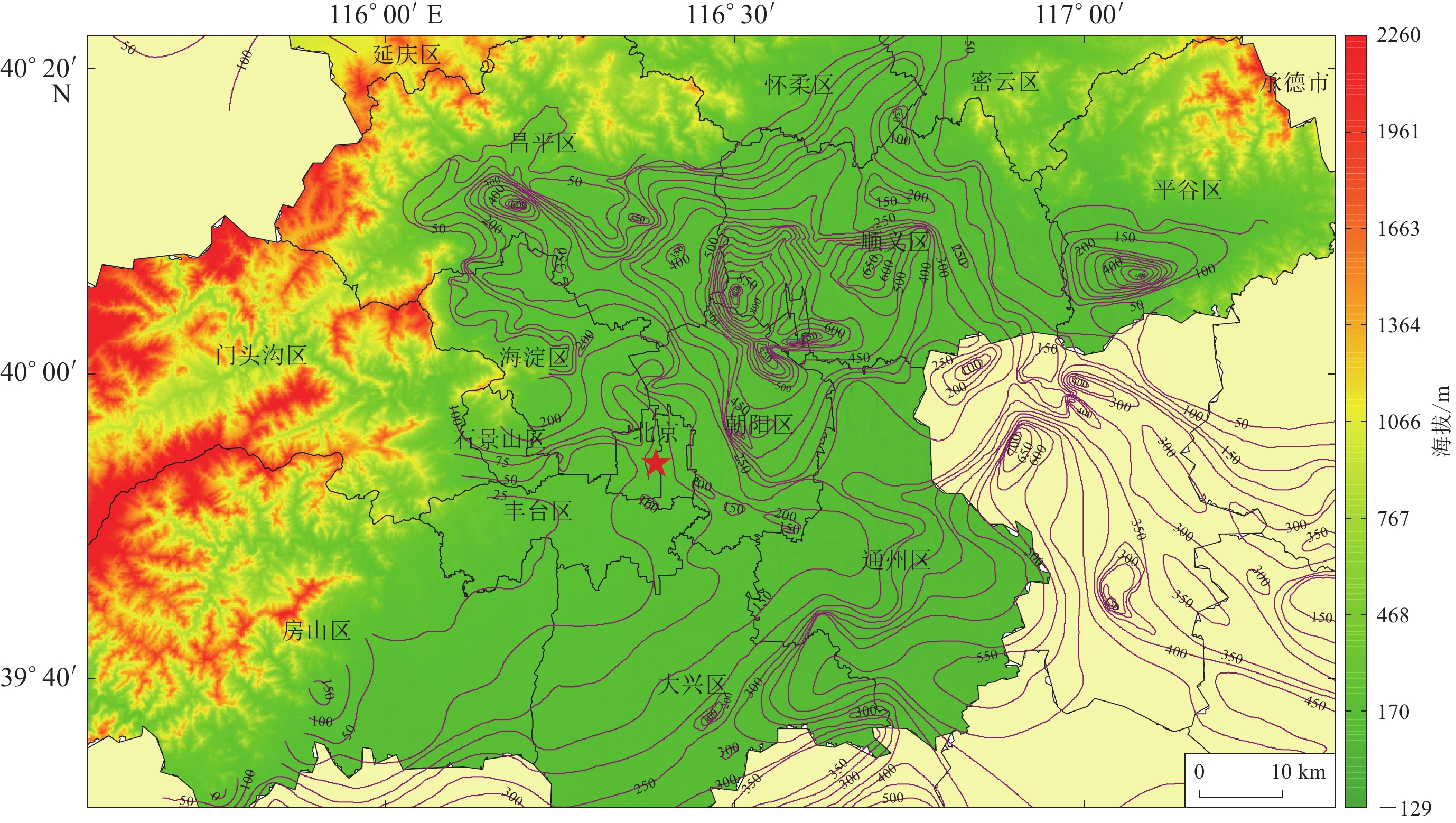
 下载:
下载:

